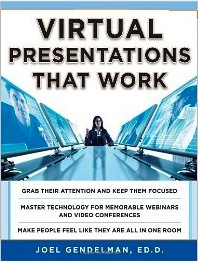Joel Gendelman has produced a basic how-to book for those who are new to virtual meeting tools. He provides guidelines and examples that apply to any tool. His promise is that he will give the reader a path to making virtual presentations that are “as effective as, and more compelling than, face-to-face presentations.”
 To
many of his readers, skeptical of claims about technology, this will
probably seem overly bold, but he cites research that supports his
assertion. On the other hand, those who have already experienced
effective virtual presentations know that his objective is
attainable, but only with good guidance and plenty of practice.
To
many of his readers, skeptical of claims about technology, this will
probably seem overly bold, but he cites research that supports his
assertion. On the other hand, those who have already experienced
effective virtual presentations know that his objective is
attainable, but only with good guidance and plenty of practice.
Fast out of the blocks
Gendelman gets right down to the business of giving that good guidance. He compares the process of showing experienced face-to-face presenters (his intended audience) how to deliver in an online environment to the process of teaching a pilot, one who already knows how to fly a plane in good weather and daylight, to fly by instruments. It’s a good analogy.
Gendelman organized the book’s 277 tightly written, well-planned pages are organized into 33 short chapters and seven appendices. He explains what makes virtual presentations work and when to use them, and gives examples of ways in which businesses are using them to increase their success. He then takes the reader through all the steps, from planning and preparation (broken down to what must happen one month, one week, and one day before the presentation), to the techniques that work when gaining attention and engaging the audience, presenting information and demonstrations, promoting interaction, excitement, and motivation, and ending with a bang.
There’s practical advice on handling the inevitable technical problems, overcoming silence and resistance, and controlling the audience. Joel also explains how to convert an existing face-to-face presentation to a virtual one, before wrapping up with a case-study exercise.
Throughout the book, readers encounter a series of worksheets that invite them to take action and that give them handy checklists they can use each time they prepare and deliver a virtual presentation. This is a very effective way to give the new virtual presenter a sense of confidence that will come through to the audience.
How to use this book
Gendelman is writing to people who will make business presentations or conduct meetings in the virtual environment. This is not a book primarily intended to prepare a subject matter expert to teach. The content could be useful to an instructor new to synchronous training, but it will not be sufficient.
I think that the best use of Joel’s book is for teaching managers, sales people, and executives to be effective online presenters, as part of a program that gives them hands-on experience. Use this book as the take-away: you won’t need handouts if you do, and the worksheets will be excellent resources for in-class exercises and discussion.
I wouldn’t rely on the book alone – trying to learn to give a great virtual presentation without the hands-on part would be a lot like trying to learn to ride a bicycle by reading a book -- a skill that needs coaching, feedback, and guidance. But this book makes a great pair of training wheels!
Publisher information
Gendelman, Joel, Ed.D. (2010) Virtual Presentations That Work. New York: McGraw-Hill. 277 pages. Publisher’s list price USD $19.95; Amazon paperback USD $12.92; Kindle Edition USD $9.99. ISBN 978-0-07-173936-8.



